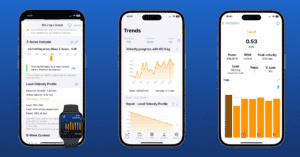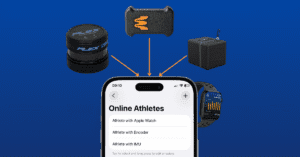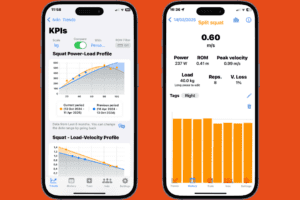En el entrenamiento de fuerza, comprender tu 1RM (Una repetición máxima) es un cambio de juego. Tu 1RM máx es el peso máximo que puedes levantar en una sola repetición, y es crucial conocer esta cifra si quieres optimizar tu plan de entrenamiento. En Spleeft, creemos que todos, ya sean atletas profesionales o aficionados al gimnasio, deberían saber cómo calcular su... repetición máxima y hacer un seguimiento eficaz de tus progresos. Con la ayuda de la tecnología moderna y el rastreador de velocidad, podemos eliminar las conjeturas a la hora de calcular tu 1RM.
En esta publicación, le mostraremos las diferentes formas en que puede calcular su 1RM máx. También profundizaremos en cómo nuestro app para la velocidad Puede ayudarte no solo a estimar tu 1RM, sino también a monitorear tu velocidad y fuerza a lo largo del tiempo. Exploremos las formas más eficientes de determinar tu... Repetición Máxima y hacer más eficaz tu entrenamiento de fuerza.
¡DESCARGA AHORA LA APLICACIÓN SPLEEFT PARA TELÉFONO, MAC Y WATCH!
¿Qué es 1RM y Rep Máxima? ¿Por qué es importante?

Conocer su 1RM (Una repetición máxima) es una de las métricas más importantes en el entrenamiento de fuerza. Es la cantidad máxima de peso que puedes levantar para una repetición completa de un ejercicio determinado, como la sentadilla, el peso muerto o el press de banca. Monitorear tu... 1RM máx es importante porque establece un punto de referencia para tu fuerza. He aquí algunas razones por las que esto es importante:
- Intensidad de entrenamiento personalizada: Su 1RM máx ayuda a determinar la carga para las distintas fases de entrenamiento. La mayoría de los programas de fuerza basan sus esquemas de series y repeticiones en un porcentaje de su 1RM. Si conoce su 1RM, puedes asegurarte de que estás levantando el peso adecuado para alcanzar tus objetivos.
- Seguimiento del progreso: Seguimiento de su repetición máxima Con el tiempo, te permite ver si te estás volviendo más fuerte. Al evaluar periódicamente tu 1RM, si lo desea, puede ajustar la intensidad y el volumen del entrenamiento para evitar las mesetas.
- Prevenir el sobreentrenamiento: Trabajar demasiado cerca de su 1RM sin una recuperación adecuada puede provocar fatiga y lesiones. Medir y ajustar regularmente su 1RM máx garantiza que no te esfuerces demasiado.
Cómo seguir tu progreso en 1RM con Spleeft
Monitorear tu progreso en 1RM es esencial para comprender cómo evoluciona tu fuerza con el tiempo y garantizar que tu entrenamiento siga siendo efectivo. Con la app Spleeft, monitorear tu 1RM es más fácil y preciso que nunca. Así es como Spleeft te ayuda a controlar tu progreso:
1. Seguimiento automatizado del progreso
Spleeft realiza un seguimiento y registra automáticamente tu progreso de 1RM para cada ejercicio a lo largo del tiempo. La aplicación genera gráficos claros y fáciles de leer que muestran cómo cambia tu 1RM estimado mes a mes. Esto te ayuda a identificar tendencias, como mejoras constantes, estancamientos o incluso períodos de regresión, lo que te permite ajustar tu plan de entrenamiento en consecuencia.
2. Actualizaciones en tiempo real con datos de velocidad
A diferencia de los métodos tradicionales que requieren una prueba física de tu máximo, Spleeft utiliza un entrenamiento basado en la velocidad para estimar tu 1RM en tiempo real. Al medir la velocidad de cada levantamiento, la aplicación calcula tu 1RM estimado sin necesidad de arriesgarte a sufrir lesiones al intentar un levantamiento máximo real. Esta función garantiza que obtengas datos precisos y prácticos cada vez que entrenas.
3. Perspectivas sobre la eficacia de la formación
Las herramientas de visualización de la aplicación te ofrecen una visión clara de cómo tu programa de entrenamiento está afectando tu fuerza. Por ejemplo, puedes ver si ciertas fases, como la hipertrofia o los bloques de fuerza, están produciendo ganancias mensurables en tu 1RM. Esto te ayuda a ajustar tu programación para maximizar los resultados.
4. Establezca metas y celebre los logros
Con Spleeft, puedes establecer objetivos de fuerza específicos, como aumentar tu 1RM en sentadillas en 10 kg en seis meses. La aplicación te mantiene motivado mostrándote tu progreso hacia estos objetivos, convirtiendo cada pequeña mejora en un hito que vale la pena celebrar.
5. Progresión segura e inteligente
Al basarse en estimaciones basadas en la velocidad en lugar de en pruebas reales de 1RM, Spleeft minimiza el riesgo de sobreentrenamiento y lesiones. Puede entrenar con confianza, sabiendo que su progreso se controla de manera segura y eficaz.
Usa la función de seguimiento de 1RM de Spleeft para monitorear tu rendimiento como nunca antes. Con datos visuales a tu alcance, sabrás exactamente cuánto has avanzado y dónde concentrar tus esfuerzos.
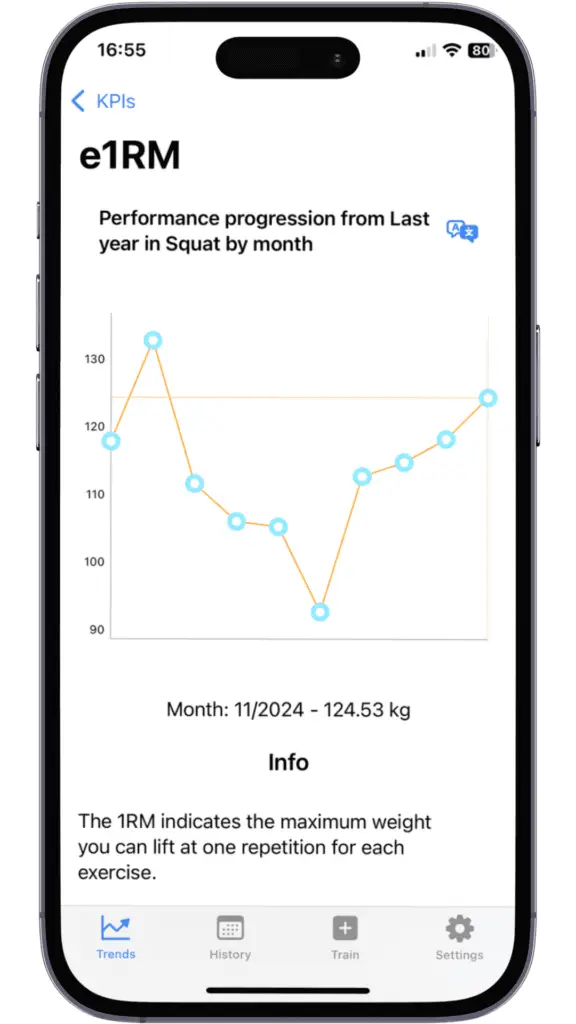
Métodos tradicionales para medir 1RM
Existen varios métodos para calcular su 1RM En el gimnasio. A continuación, exploraremos algunas de las formas más comunes, tanto directas como indirectas, y cómo usarlas de forma segura para encontrar tu... Repetición Máxima.
1. Prueba directa con calculadora de 1RM
Este es el método más sencillo e implica levantar el máximo peso que puedas soportar para una repetición. Si bien esto proporciona una cifra precisa, no está exento de riesgos, especialmente para principiantes. Pon a prueba tu... 1RM máx esta forma suele reservarse a los levantadores experimentados que saben cómo realizar levantamientos pesados de forma segura.
El proceso suele implicar un calentamiento, seguido de un aumento de peso hasta alcanzar el máximo esfuerzo. Sin embargo, debido a los riesgos que conlleva (posibilidad de lesiones o fatiga), no siempre es la mejor opción para todos.
2. Estimación de 1RM a partir de repeticiones submáximas
Si no te sientes cómodo levantando tu peso máximo, puedes estimar tu 1RM utilizando una fórmula que lo calcula en función de cuántas repeticiones puedes completar con una carga más ligera. Esta es una de las formas más seguras y populares de calcular tu repetición máxima.
Una ecuación muy utilizada es la Fórmula de Epley:
1RM = Peso × (1 + (0,0333 × Repeticiones)) 1RM = Peso por (1 + (0,0333 veces Repeticiones))1RM=Weight×(1+(0.0333×RePs))
Por ejemplo, si puede levantar 200 libras durante 5 repeticiones, su 1RM máx sería:
1RM=200×(1+(0,0333×5))=233 libras1RM = 200 veces (1 + (0,0333 veces 5)) = 233 libras1RM=200×(1+(0.0333×5))=233lbs
Este método es más seguro y más fácil para la mayoría de las personas, especialmente si entrenas solo o no quieres arriesgarte a sufrir lesiones por esforzarte al máximo.
3. 1RM Max Calculadora Herramientas
Muchos atletas de fuerza confían en Calculadoras de 1RM Máx para hacer el trabajo pesado (juego de palabras) de determinar su máximo. A en Calculo de 1RM utiliza fórmulas similares a las mencionadas y puede estimar su Repetición Máxima en función del peso y las repeticiones realizadas. En Spleeft, nuestra app incorpora un avanzado en Calculo de 1RM dentro de nuestro rastreador de velocidad para ayudarte a estimar tu peso máximo basándote en datos en tiempo real.
Nuestra app para la velocidad calcula su 1RM máx Se basa en la velocidad a la que mueves un peso determinado, por lo que no necesitas arriesgarte al intentar un levantamiento máximo real. Esto lo convierte en una solución ideal para quienes buscan mejorar su rendimiento de forma segura.
Estimación de 1RM a partir de múltiples series de repeticiones: De 10RM a 1RM
Si tiene su 10RM (10 Rep Max)puede utilizarlo para calcular su 1RM. Muchas personas prefieren probar rangos de repetición más altos como 10RM en lugar del 1RM máx por razones de seguridad y practicidad. Convertir su 10RM a 1RM es relativamente sencillo con una fórmula similar a las mencionadas anteriormente, o utilizando tablas de conversión.
Estimar 1RM a partir de 10RM, puede volver a utilizar la función Fórmula de Epley o una tabla de conversión. La conversión para 10RM a 1RM sería algo así:
Si levantas 150 libras por 10 repeticiones:
1RM=150×(1+(0,0333×10))=199 libras1RM = 150 veces (1 + (0,0333 veces 10)) = 199 libras1RM=150×(1+(0.0333×10))=199lbs
Este método es popular porque es más seguro y levantar más repeticiones reduce el riesgo de lesiones.
El papel de la velocidad en el cálculo de 1RM
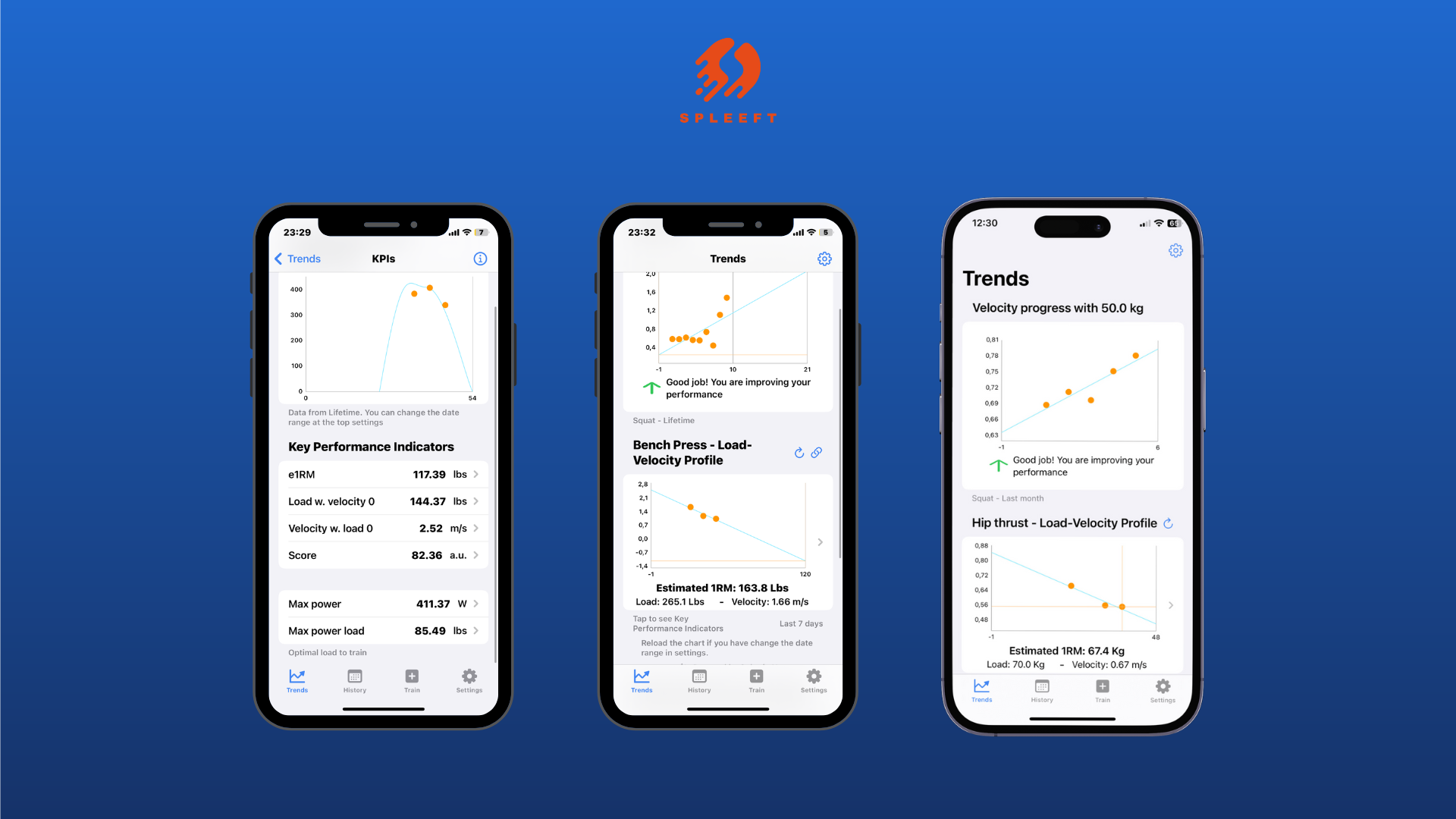
Entrenamiento basado en la velocidad (VBT) ha cambiado las reglas del juego a la hora de medir la fuerza. La velocidad a la que mueves un peso puede ser un indicador clave de tu fuerza máxima, y aquí es donde Spleeft realmente brilla. Al utilizar nuestro app para la velocidadpodemos seguir la velocidad de tu barra y estimar tu 1RM máx sin necesidad de llegar al máximo en el sentido tradicional.
En el entrenamiento basado en la velocidad, existe una relación clara entre la carga y el velocidad a la que se desplaza el peso. A medida que aumenta la carga, disminuye la velocidad de movimiento. Esta relación puede representarse gráficamente para formar una perfil carga-velocidady utilizando estos datos, podemos predecir su Repetición Máxima con notable precisión.
Cómo funciona el rastreador de velocidad de Spleeft
Nuestra rastreador de velocidad mide la velocidad de cada repetición y registra estos datos para ayudar a crear un detallado perfil carga-velocidad para cada ejercicio. Basándonos en la repetición más rápida que realices con cualquier carga, estimamos el 1RM máx y te da retroalimentación sobre cómo ajustar tu entrenamiento. Es un enfoque de entrenamiento más inteligente y basado en datos que ayuda a los atletas a tomar decisiones en tiempo real en el gimnasio.
Al realizar un seguimiento tanto de la velocidad como de la fuerza, no solo puede calcular su repetición máxima sino también optimizar tu potencia y evitar el agotamiento.
Cómo crear un perfil de velocidad de carga
Crear un perfil de carga-velocidad es esencial para comprender la relación entre el peso levantado y la velocidad de ejecución, lo que te permite estimar métricas clave como tu 1RM y optimizar tu rendimiento. Estos son los pasos básicos para hacerlo con Spleeft:
- Seleccione un ejercicio: Elija un movimiento como sentadillas, press de banca o peso muerto.
- Velocidades récord: Utilice el rastreador de velocidad de Spleeft para registrar la velocidad de su repetición más rápida con diferentes pesos.
- Graficar los datos: La aplicación generará automáticamente una curva inversa que muestra cómo la velocidad disminuye a medida que aumenta la carga.
- Analizar y ajustar: Basándose en el perfil generado, Spleeft calculará tu 1RM y te proporcionará información clave, como tu velocidad máxima y tu carga de trabajo óptima.
Otras métricas clave para realizar un seguimiento de su rendimiento en materia de fuerza
Además de 1RM, existen otras métricas cruciales que puedes monitorear para medir y mejorar tu rendimiento. Una de las más importantes es carga de potencia máxima, que indica el peso con el que se alcanza la máxima potencia. Esto resulta especialmente útil para:
- Planificación de entrenamientos efectivos: Conocer la carga óptima con la que empezar para maximizar la potencia.
- Cómo evitar pruebas de 1RM constantes: Una métrica menos exigente y más segura para seguir el progreso.
- Mejorar el rendimiento en deportes explosivos: Ideal para deportistas que necesitan combinar fuerza y velocidad.
Con Spleeft, puedes identificar esta carga y ajustar tu entrenamiento para mantenerte dentro de tu rango de potencia máxima, optimizando cada sesión.
Métodos alternativos para medir la fuerza en el gimnasio
Mientras que las tradicionales Calculadoras de 1RM y los métodos basados en la velocidad son populares, existen otras formas de estimar la fuerza sin utilizar un 1RM máx o repetición máxima. Exploremos algunos:
1. Entrenamiento basado en la velocidad
Ya hemos mencionado cómo rastreadores de velocidad puede estimar 1RM Basado en la velocidad del movimiento. Este método es increíblemente efectivo porque te permite entrenar de forma segura y, al mismo tiempo, obtener información valiosa sobre tu rendimiento. Es especialmente útil para atletas que quieren evitar alcanzar el límite, pero que necesitan una forma fiable de estimar su rendimiento. 1RM máx.
2. Predicción de repetición con cargas más ligeras
Otro método consiste en levantar cargas ligeras hasta el fallo y utilizar ese número para predecir tu 1RM. Si bien este método no es tan preciso como el entrenamiento basado en la velocidad, sigue siendo una buena manera de aproximarse a sus niveles de fuerza sin riesgo de lesiones.
3. Pruebas basadas en la potencia
Para los levantamientos explosivos, como los olímpicos o los pliométricos, la medición de la potencia de salida puede proporcionar otra dimensión de las pruebas de fuerza. Aunque no está directamente relacionada con 1RMEstas pruebas pueden darte una idea de cuánto peso podrías levantar, especialmente para los atletas que entrenan la velocidad y la potencia.
Beneficios de Calc 1RM con Spleeft
En Spleeft, creemos que el uso de la tecnología para realizar un seguimiento de su progreso es el futuro del entrenamiento de fuerza. Con nuestro app para la velocidadno sólo obtendrá datos en tiempo real sobre sus ascensores, sino también un cálculo preciso de los mismos. 1RM para usted. Estas son algunas de las ventajas de utilizar Spleeft para tu entrenamiento:
- Seguridad: Si se basa en los datos de velocidad en lugar de levantar hasta el fallo, puede reducir el riesgo de lesiones.
- Precisión: Nuestra en Calculo de 1RM utiliza algoritmos de vanguardia para proporcionar resultados precisos basados en su perfil único de carga-velocidad.
- Seguimiento del progreso: Puedes seguir tus progresos a lo largo del tiempo y ver cómo mejora tu fuerza.
- Eficacia:Sabrás exactamente cuánto peso levantar cada día, evitando fatiga innecesaria y maximizando ganancias.
Conclusión
Comprender y calcular su 1RM máx es clave para sacar el máximo partido a su programa de entrenamiento de fuerza. Tanto si prefieres utilizar métodos tradicionales, Calculadoras de 1RM, o herramientas más avanzadas como rastreador de velocidad, lo importante es disponer de datos precisos sobre tus niveles de fuerza.
En Spleeft, nos comprometemos a ayudarle a alcanzar sus objetivos con precisión y seguridad. Nuestro app para la velocidad le permite estimar su repetición máxima con facilidad, realiza un seguimiento de tu rendimiento y toma decisiones más inteligentes en el gimnasio. Empieza a usar Spleeft hoy mismo y toma el control de tu entrenamiento como nunca antes.


